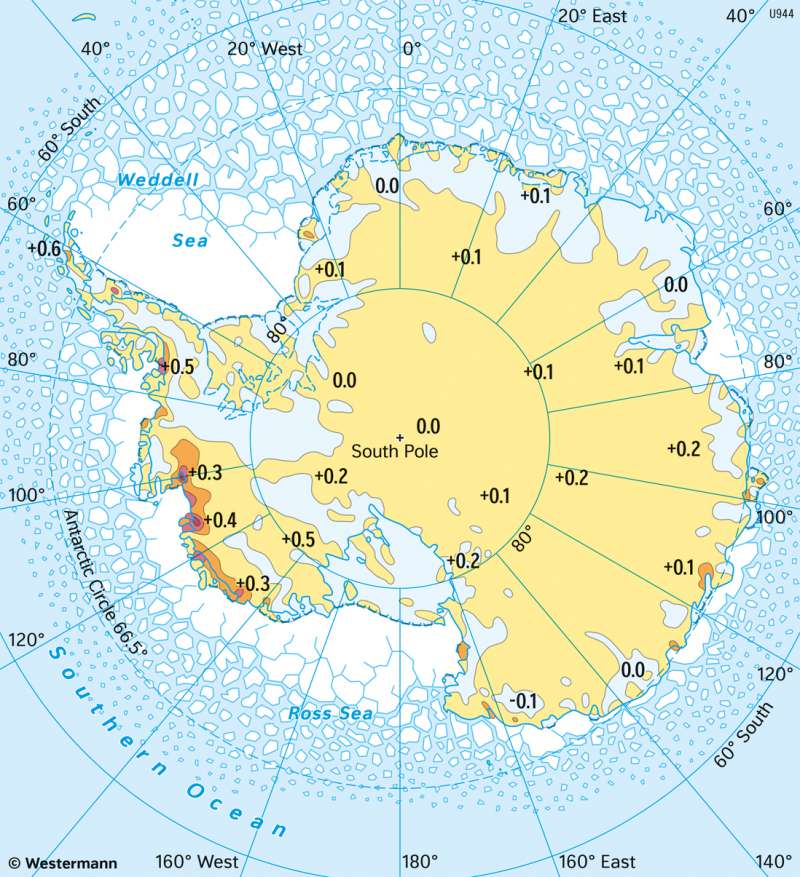Antarctic - Ice conditions
Human activities and environmental change
978-3-14-100890-6 | Page 200 | Ill. 2

Overview
Warming climate, sea-level rises, extreme ocean water levels and a shrinking cryosphere are together affecting polar regions, including Antarctica. Data from an IPCC special report on the oceans and cryosphere clearly show that over the last decades, global warming has led to widespread reduction of the cryosphere. Between 2006 and 2015, the Antarctic ice sheet lost mass at an average rate of 155 ± 19 Gt per year (0.43 ± 0.05 mm per year). This was mainly due to a rapid decrease in thickness and the retreat of important outlet glaciers draining the West Antarctic Ice Sheet (IPCC 2019:4). However, unlike the Arctic, Antarctic sea ice extent does not show a statistically significant trend (1979-2018) due to opposing regional growth trends and high variability in values over the centuries (IPCC 2019:4).
Ocean warming and the Antarctic ice shield
Since 1970, oceans have warmed constantly and the rate has more than doubled since 1993. Since 1982, the frequency of marine heat waves has doubled and their intensity has also increased. At the same time, an increase in temperatures has also been measured in large parts of Antarctica since 1958. In western Antarctica, values range up to +0.5 °C per decade.
In addition to warming, a rise in mean global sea level can also be observed and has accelerated in recent decades. This is due to the increasing rate of ice loss from the Greenland and Antarctic ice sheets, ongoing glacier mass loss and thermal expansion of the oceans. The Antarctic ice sheet lost three times as much mass between 2007 and 2016 as it did between 1997 and 2006 (IPCC 2019:8). This acceleration of ice flow (confer map 200.2) and ice retreat in Antarctica is observed mainly in the West Antarctic Amundsen Bay and Wilkes Land in East Antarctica. These processes can lead to a sea level rise of several metres within a few centuries, if unabated. It is conceivable that this is the beginning of irreversible ice sheet instability. Uncertainty exists because there are only limited observational data sets, model representations of ice sheet processes are inadequate, and there is not yet a complete understanding of the interactions between atmosphere, ocean and ice sheet (IPCC 2019:8).
Author: Sarah Franz
Projections for the future
In future, the Antarctic ice sheet, like the Arctic ice sheet, will continue to lose mass at an increasing rate throughout the 21st century and beyond. The rate of change will depend on the change in greenhouse gas emissions. Under the RCP2.6 scenario, the contribution of the Antarctic ice sheet to sea level rise will vary between 4 cm in 2100 (total sea level rise as against the mean of 1986-2005: 43 cm) and under the RCP8.5 scenario a contribution of 12 cm (total sea level rise as against the mean of 1986-2005: 84 cm; IPCC 2019:18). Currently, the Greenland Ice Sheet contributes even more to sea level rise than the Antarctic Ice Sheet, but the ratio could shift by 2100. However, there is still greater uncertainty regarding developments on the Antarctic Ice Sheet. In particular, processes that control ice shelf loss and the extent of ice sheet stability (e.g. sea water warming, sea level rise) should be monitored more closely, as they could significantly increase the Antarctic contribution to sea level rise if they involve a partial collapse of the Antarctic ice sheet.
Overall, warming, ocean acidification and continued loss of multi-year sea ice will affect polar marine ecosystems, reducing Antarctic krill habitats southwards in the Southern Ocean. Penguins, seals and whales will also be affected, as krill form their base of food.
Source:
IPCC, 2019: Zusammenfassung für politische Entscheidungsträger. In: IPCC-Sonderbericht über den Ozean und die Kryosphäre in einem sich wandelnden Klima [H.-O. Pörtner, D.C. Roberts, V. Masson-Delmotte, P. Zhai, M. Tignor, E. Poloczanska, K. Mintenbeck, A. Alegría, M. Nicolai, A. Okem, J. Petzold, B. Rama, N.M. Weyer (Hrsg.)]. In Druck. Deutsche Übersetzung auf Basis der Onlineversion inklusive Errata vom 2. März 2020. Deutsche IPCC-Koordinierungsstelle, Bonn, Januar 2021.
https://www.de-ipcc.de/media/content/SROCC-SPM_de_barrierefrei.pdf




